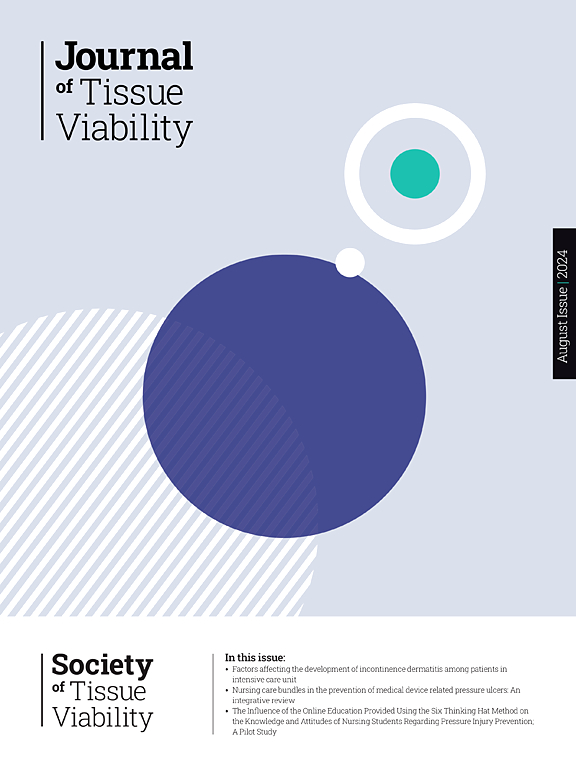Diabetic foot care behavior and self-efficacy levels in individuals with diabetic foot ulcers in Turkey
IF 2.4
3区 医学
Q2 DERMATOLOGY
引用次数: 0
Abstract
Objective
This study aimed to explore the connection between demographic characteristics, diabetes-related knowledge, foot self-care behaviors, and self-efficacy levels in individuals with diabetic foot ulcers. Additionally, it investigated whether there is a correlation between foot care behaviors and self-efficacy levels among these individuals.
Methods
This descriptive and cross-sectional study was conducted with individuals who applied to a training and research hospital with a diabetic foot ulcer and received treatment between October 2019 and October 2020. Data were collected through the Patient Identification Characteristics Form, the Diabetes Management Self-Efficacy Scale, and the Foot Self-Care Behavior Scale. Percentage, mean, Mann-Whitney U test, Kruskal-Wallis test, and Spearman correlation analysis were used to analyze the data.
Results
The mean self-efficacy score among individuals with diabetic foot ulcers was 68.39 ± 14.03, while the mean foot self-care behavior score was 59.10 ± 10.13. Previous diabetes education, regular exercise, and educational status significantly influenced scores on both scales. Furthermore, a positive linear relationship was observed between foot self-care behaviors and self-efficacy levels in individuals with diabetic foot.
Conclusions
To enhance self-efficacy levels and promote foot self-care behaviors in individuals with diabetic foot ulcers, continuous education, and regular follow-up examinations are essential. Providing tailored care based on demographic characteristics and evolving health conditions related to diabetes is expected to reduce complications effectively.
土耳其糖尿病足溃疡患者的糖尿病足护理行为和自我效能水平
目的探讨糖尿病足溃疡患者的人口学特征、糖尿病相关知识、足部自我保健行为和自我效能感水平之间的关系。此外,本研究还调查了这些个体的足部护理行为与自我效能水平之间是否存在相关性。方法对2019年10月至2020年10月期间申请到一家培训和研究医院接受治疗的糖尿病足溃疡患者进行了描述性和横断面研究。通过患者识别特征表、糖尿病管理自我效能感量表和足部自我护理行为量表收集数据。采用百分比、均值、Mann-Whitney U检验、Kruskal-Wallis检验和Spearman相关分析对数据进行分析。结果糖尿病足溃疡患者自我效能感得分均值为68.39±14.03分,足部自我护理行为得分均值为59.10±10.13分。既往糖尿病教育、定期运动和教育状况对两种量表的得分均有显著影响。此外,糖尿病足患者足部自我护理行为与自我效能水平之间存在正线性关系。结论要提高糖尿病足溃疡患者的自我效能感水平,促进足部自我保健行为,需要持续教育和定期随访检查。根据与糖尿病相关的人口特征和不断变化的健康状况提供量身定制的护理,预计将有效减少并发症。
本文章由计算机程序翻译,如有差异,请以英文原文为准。
求助全文
约1分钟内获得全文
求助全文
来源期刊

Journal of tissue viability
DERMATOLOGY-NURSING
CiteScore
3.80
自引率
16.00%
发文量
110
审稿时长
>12 weeks
期刊介绍:
The Journal of Tissue Viability is the official publication of the Tissue Viability Society and is a quarterly journal concerned with all aspects of the occurrence and treatment of wounds, ulcers and pressure sores including patient care, pain, nutrition, wound healing, research, prevention, mobility, social problems and management.
The Journal particularly encourages papers covering skin and skin wounds but will consider articles that discuss injury in any tissue. Articles that stress the multi-professional nature of tissue viability are especially welcome. We seek to encourage new authors as well as well-established contributors to the field - one aim of the journal is to enable all participants in tissue viability to share information with colleagues.
 求助内容:
求助内容: 应助结果提醒方式:
应助结果提醒方式:


